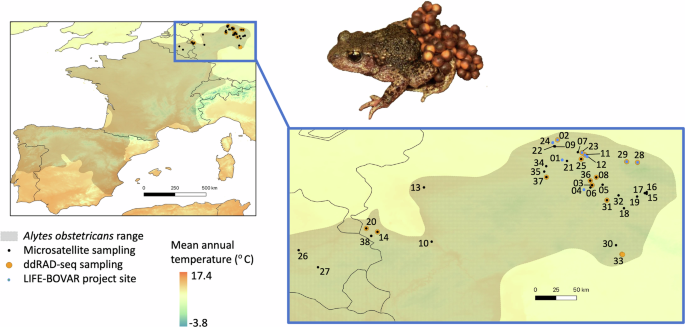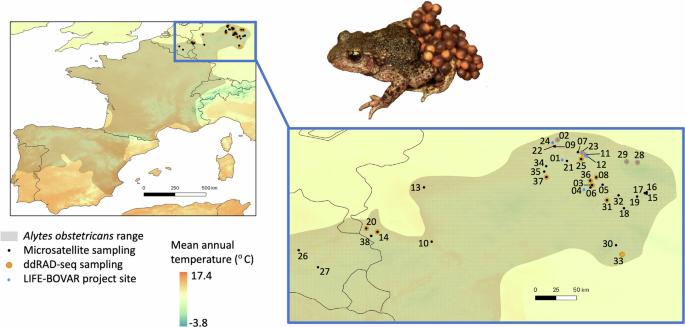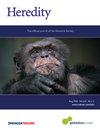最大限度地发挥种群进化潜力的决策框架--普通助产士蟾蜍(Alytes obstetricans)在其分布极限的遗传学和基因组学见解。
IF 3.9
2区 生物学
Q2 ECOLOGY
引用次数: 0
摘要
人类活动对栖息地的改变和气候变化是导致生物多样性减少的根本原因,它们降低了物种的进化潜力,尤其是在其分布极限地区。为了补充衰退的种群,通常会进行支持性繁殖或重新引入个体,有时也会通过遗传分析提供信息。然而,大多数采用的方法(即单基因座标记)都无法解释当地对环境条件的适应性,而这是选择供体和受体种群时需要考虑的一个重要方面。在这里,我们结合遗传(微卫星)和全基因组 SNP(ddRAD-seq)标记,考虑中性和假定的适应性遗传多样性,为受威胁的普通助产士蟾蜍(Alytes obstetricans)在欧洲分布区北部和东部边缘的保护管理提供信息。我们发现了具有地理结构的种群(n = 4)、较弱的遗传分化以及各地相当一致的遗传多样性水平(观察到的杂合度和等位基因丰富度)。根据基因组中可能具有适应性的区域对个体进行分类后发现,大多数地方的适应性并不强。然而,有几个地方出现了大量私有等位基因,这与当地对温暖条件和崎岖地形的适应有关。结合遗传多样性和当地适应性以及迁移率的估计,我们建立了一个选择供体和受体种群的决策框架,从而最大限度地提高中性和假定适应性遗传多样性的地理分布。我们的框架普遍适用于任何物种,尤其是两栖动物,因此有了这些信息,保护工作者就可以避免将不合适/不适应的个体重新引入新的地点,并提高物种内种群的进化潜力。本文章由计算机程序翻译,如有差异,请以英文原文为准。


A decision-making framework to maximise the evolutionary potential of populations - Genetic and genomic insights from the common midwife toad (Alytes obstetricans) at its range limits
Anthropogenic habitat modification and climate change are fundamental drivers of biodiversity declines, reducing the evolutionary potential of species, particularly at their distributional limits. Supportive breeding or reintroductions of individuals are often made to replenish declining populations, sometimes informed by genetic analysis. However, most approaches utilised (i.e. single locus markers) do not have the resolution to account for local adaptation to environmental conditions, a crucial aspect to consider when selecting donor and recipient populations. Here, we incorporate genetic (microsatellite) and genome-wide SNP (ddRAD-seq) markers, accounting for both neutral and putative adaptive genetic diversity, to inform the conservation management of the threatened common midwife toad, Alytes obstetricans at the northern and eastern edges of its range in Europe. We find geographically structured populations (n = 4), weak genetic differentiation and fairly consistent levels of genetic diversity across localities (observed heterozygosity and allelic richness). Categorising individuals based on putatively adaptive regions of the genome showed that the majority of localities are not strongly locally adapted. However, several localities present high numbers of private alleles in tandem with local adaptation to warmer conditions and rough topography. Combining genetic diversity and local adaptations with estimates of migration rates, we develop a decision-making framework for selecting donor and recipient populations which maximises the geographic dispersal of neutral and putatively adaptive genetic diversity. Our framework is generally applicable to any species, but especially to amphibians, so armed with this information, conservationists may avoid the reintroduction of unsuitable/maladapted individuals to new sites and increase the evolutionary potential of populations within species.
求助全文
通过发布文献求助,成功后即可免费获取论文全文。
去求助
来源期刊

Heredity
生物-进化生物学
CiteScore
7.50
自引率
2.60%
发文量
84
审稿时长
4-8 weeks
期刊介绍:
Heredity is the official journal of the Genetics Society. It covers a broad range of topics within the field of genetics and therefore papers must address conceptual or applied issues of interest to the journal''s wide readership
 求助内容:
求助内容: 应助结果提醒方式:
应助结果提醒方式:


